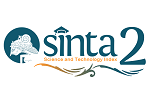Konstruksi makna pegiat Kelompok Dongeng Bengkimut
Abstract
Keywords
Full Text:
PDFReferences
Aliyah, S. (2011). Pengaruh metode storytelling dengan media panggung boneka terhadap peningkatan kemampuan menyimak dan berbicara anak usia dini: Studi eksperimen quasi di TK Negeri Pembina Kabupaten Majalengka (Tesis) [Universitas Pendidikan Indonesia, Bandung]. http://repository.upi.edu/8747/
Ardini, P. P. (2012). Pengaruh dongeng dan komunikasi terhadap perkembangan moral anak usia 7-8 tahun. Jurnal Pendidikan Anak, 1(1), 44–58. https://doi.org/10.21831/jpa.v1i1.2905
Habsari, Z. (2017). Dongeng sebagai pembentuk karakter anak. BIBLIOTIKA: Jurnal Kajian Perpustakaan Dan Informasi, 1(1), 21–29. https://doi.org/10.17977/um008v1i12017p021
Istiani, A. N. (2015). Konstruksi makna hijab fashion bagi moslem fashion blogger. Jurnal Kajian Komunikasi, 3(1), 48–55. https://doi.org/10.24198/jkk.v3i1.7393
Mokhtar, N. H., Halim, M. F. A., & Kamarulzaman, S. Z. S. (2011). The effectiveness of storytelling in enhancing communicative. Procedia-Social and Behavioral Sciences, 18(1), 163–169. https://doi.org/10.1016/j.sbspro.2011.05.024
Nuryana, A., Pawito, & Utari, P. (2019). Pengantar metode penelitian kepada suatu pengertian yang mendalam mengenai konsep fenomenologi. Ensains Journal, 2(1), 19–24. https://doi.org/10.31848/ensains.v2i1.148
Nuryanto, S., & Izzaty, R. E. (2016). Peranan dongeng dalam pendidikan karakter pada Taman Kanak-kanak Lazuardi Kamila di Surakarta. JPPM: Jurnal Pendidikan Dan Pemberdayaan Masyarakat, 3(1), 75–84. https://doi.org/10.21831/jppm.v3i1.8063
Saparwati, M. (2012). Studi fenomenologi: Pengalaman kepala ruang dalam mengelola Ruang Rawat di RSUD Ambarawa (Tesis) [Universitas Indonesia, Depok]. http://lib.ui.ac.id/file?file=digital/20302623-T30332-Studi fenomenologi.pdf
Spaulding, A. E. (2011). The art of storytelling telling truths through telling stories. California: The Scarecrow Press.
Sugiyono. (2016). Metode penelitian kuantitatif, kualitatif dan R & D. Bandung: Alfabeta.
Sukarno, Permanasari , A., & Hamidah, I. (2016). The profile of science process skill (SPS) students of secondary high school: Case study in Jambi. International Journal of Scientific Engineering and Research (IJSER), 1(1), 79–83. https://www.ijser.in/archives/v1i1/MDExMzA5MTg=.pdf
Suzuki, W. A., Feliú-Mójer, M. I., Hasson, U., Yehuda, R., & Zarate, J. M. (2018). Dialogues: The science and power of storytelling. JNeurosci: The Journal of Neuroscience, 38(44), 9468–9470. https://doi.org/10.1523/JNEUROSCI.1942-18.2018
Utomo, S. B. (2013). Mendongeng dalam perspektif pendidikan. Agastya: Jurnal Sejarah Dan Pembelajarannya, 3(1), 1–8. https://doi.org/10.25273/ajsp.v3i01.901
DOI: https://doi.org/10.24198/jkip.v8i1.26637
Refbacks
- There are currently no refbacks.
Copyright (c) 2020 Jurnal Kajian Informasi & Perpustakaan

This work is licensed under a Creative Commons Attribution-ShareAlike 4.0 International License.
Jurnal Kajian Informasi & Perpustakaan Indexed by:
Jurnal Kajian Informasi & Perpustakaan
Program Studi Perpustakaan dan Sains Informasi d.h. Program Studi Ilmu Perpustakaan
Fakultas Ilmu Komunikasi, Universitas Padjadjaran
Jl. Raya Bandung-Sumedang Km. 21 Jatinangor, Sumedang, Indonesia 45363
WA: +62 813-1323-7581 (Chat Only)
Telepon: +62227796954
Faksimile: +62227794122
email: jkip.fikom@unpad.ac.id
Jurnal Kajian Informasi & Perpustakaan is licensed under a Creative Commons Attribution-ShareAlike 4.0 International License
Jurnal Kajian Informasi & Perpustakaan supervised by:












2.png)
.png)



